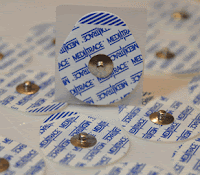Patient Monitoring:
To know the current status of their vital signs.
monitoring is common in patient transfers as being in critical situations is important to carry out tests and operated on or to enter them in the (UCI) 0 (REA).
The nursing assistant must be able to monitor the patient quickly and efficiently.
To monitor must follow the following steps:
Area connections on the monitor:
Blood Pressure Cuff:
Blood pressure is one of the parameters that will notify me of circulatory complications: bleeding, dehydration, cardiac tamponade ... Therefore the importance of having blood pressure monitored.
Blood pressure is pressure exerted by blood as it passes through the vessel walls. Is determined by cardiac output and peripheral vascular resistance.
There are two measures:
- Systolic: is the maximum pressure.
- The Diastolic : The minimum pressure.
- Hypotension
; -Diastócica:-60mmHg
- Normotensión:
-Diastócica: 60/80 mmHg
- Hipertensión:
-Diastócica: +90 mmHg
Blood Pressure is measured in mmHg (millimeters of mercury).
The cuff is placed on the arm that has not forwarded the peripheral route. 2 cm above the elbow and will be made to encompass the entire circumference of the limb (arm or leg) loosely. Adjust on the monitor how often we take blood pressure and alarm limits.
The cuff width should be 40% of the circumference of the arm and should be placed at the midpoint.
Porlotanto must have the appropriate cuff to the arm or leg of the patient.
The cuff blood pressure measurement tells you its size in Centimeters: Adult
- :25-35 inches. Children
- :18-26 inches. Child
- :10-19 centimeters. Newborn
- :5-9 inches.
Image of sizes diferntes
Conesión pulse oximeter:
oximeter : Place index finger of the patient and used to measure oxygen saturation of hemoglobin inside the blood vessels.
The heart rate:
The speed of the pulse, ie beats per minute. The monitor will give us a numerical data (heart rate) and a curve with the QRS complex and T wave The pulse varies with age, physical activity, emotional state ... normal values \u200b\u200bbetween 60 and 120 beats can detect frequencies too slow (bradycardia) or frequencies very fast (tachycardia). With heart rate monitoring are going to have continuous monitoring, is detected arrhythmias, conduction defects, myocardial ischemia and function of pacemakers.
Cable 3 and 5 lead to be coupled to the electrodes will be placed on the patient.
3-lead cable
- Red under the right shoulder (middle line clavicular)
- Yellow below left shoulder (mid-clavicular line)
- Green or black below xiphoid
5-lead Cable
- Red under the right shoulder (mid-clavicular line)
- Yellow below the left shoulder (mid-clavicular line)
- Black right upper abdomen
- Green left upper abdomen
- White , On the chest, according to the derivation you want to choose
adhesive electrodes: Iran placed on the patient as indicated above. Depending 3 or 5 lead.














0 comments:
Post a Comment